ENGR 111 Assignment: Cooling Potential of Evaporative Techniques
VerifiedAdded on 2023/06/11
|10
|1593
|115
Report
AI Summary
This report assesses the cooling potential of evaporative cooling, geothermal, and sky radiation, focusing on their application in agricultural and residential settings. It details the principles behind direct and indirect evaporative cooling, emphasizing their economic feasibility and environmental benefits. The report uses energy balance equations to quantify air supply and explores the effectiveness of these systems in different climates. It presents data from various US cities, analyzing solar fraction performance and temperature variations, alongside valve operation data and temperature measurements to evaluate system efficiency. The discussion highlights the suitability of these cooling methods in specific climate subzones, referencing relevant research and providing insights into the practical implementation of evaporative and geothermal cooling techniques.
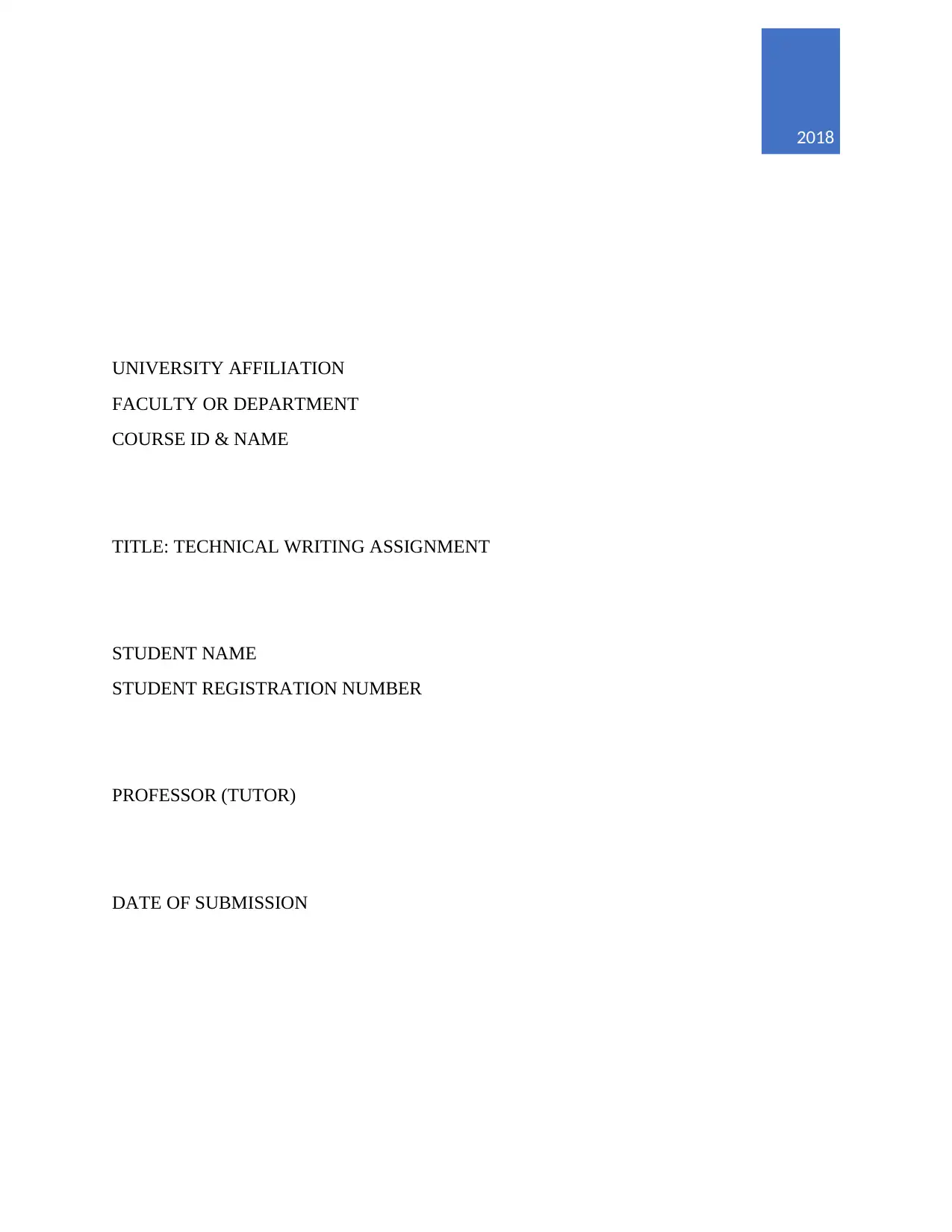
UNIVERSITY AFFILIATION
FACULTY OR DEPARTMENT
COURSE ID & NAME
TITLE: TECHNICAL WRITING ASSIGNMENT
STUDENT NAME
STUDENT REGISTRATION NUMBER
PROFESSOR (TUTOR)
DATE OF SUBMISSION
2018
FACULTY OR DEPARTMENT
COURSE ID & NAME
TITLE: TECHNICAL WRITING ASSIGNMENT
STUDENT NAME
STUDENT REGISTRATION NUMBER
PROFESSOR (TUTOR)
DATE OF SUBMISSION
2018
Paraphrase This Document
Need a fresh take? Get an instant paraphrase of this document with our AI Paraphraser
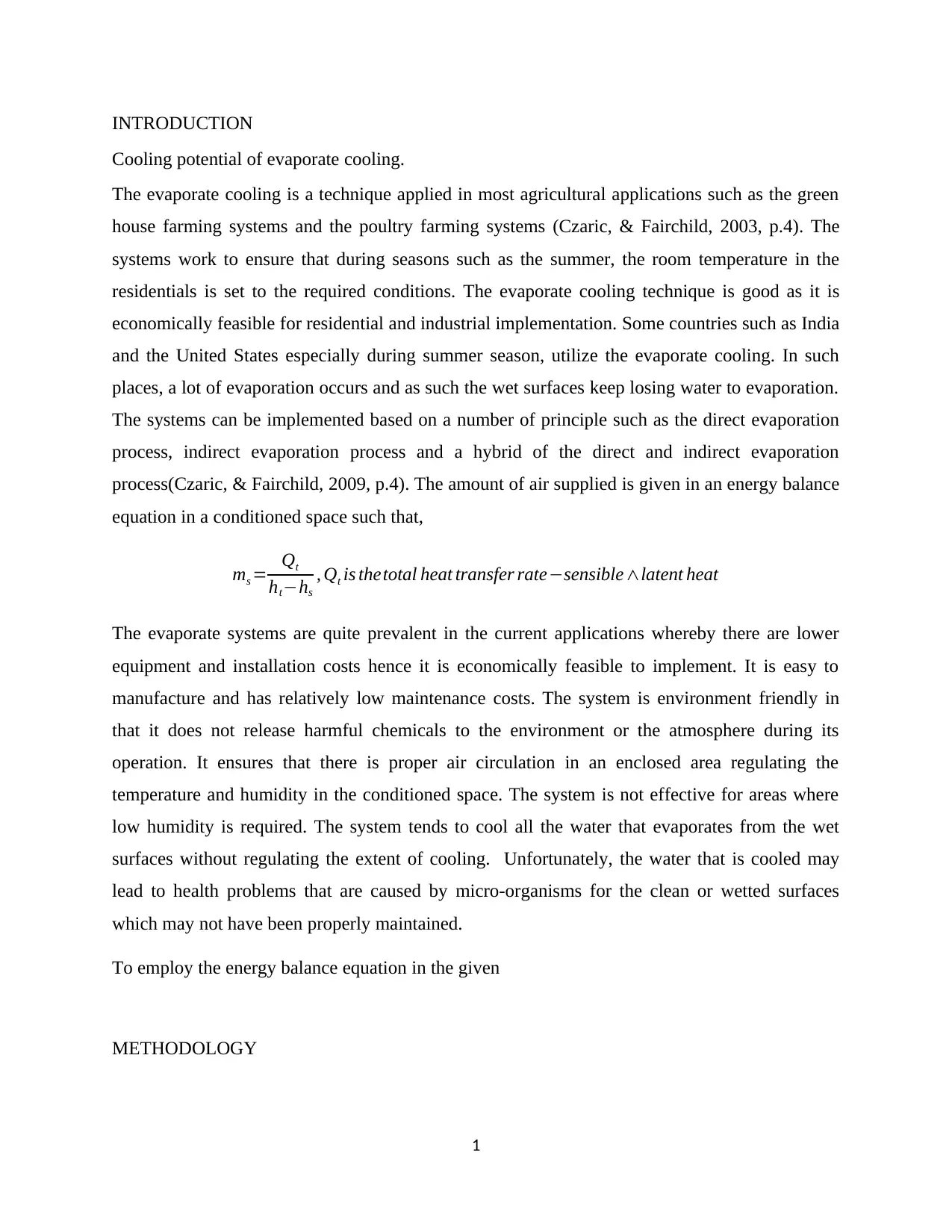
INTRODUCTION
Cooling potential of evaporate cooling.
The evaporate cooling is a technique applied in most agricultural applications such as the green
house farming systems and the poultry farming systems (Czaric, & Fairchild, 2003, p.4). The
systems work to ensure that during seasons such as the summer, the room temperature in the
residentials is set to the required conditions. The evaporate cooling technique is good as it is
economically feasible for residential and industrial implementation. Some countries such as India
and the United States especially during summer season, utilize the evaporate cooling. In such
places, a lot of evaporation occurs and as such the wet surfaces keep losing water to evaporation.
The systems can be implemented based on a number of principle such as the direct evaporation
process, indirect evaporation process and a hybrid of the direct and indirect evaporation
process(Czaric, & Fairchild, 2009, p.4). The amount of air supplied is given in an energy balance
equation in a conditioned space such that,
ms = Qt
ht−hs
, Qt is thetotal heat transfer rate−sensible ∧latent heat
The evaporate systems are quite prevalent in the current applications whereby there are lower
equipment and installation costs hence it is economically feasible to implement. It is easy to
manufacture and has relatively low maintenance costs. The system is environment friendly in
that it does not release harmful chemicals to the environment or the atmosphere during its
operation. It ensures that there is proper air circulation in an enclosed area regulating the
temperature and humidity in the conditioned space. The system is not effective for areas where
low humidity is required. The system tends to cool all the water that evaporates from the wet
surfaces without regulating the extent of cooling. Unfortunately, the water that is cooled may
lead to health problems that are caused by micro-organisms for the clean or wetted surfaces
which may not have been properly maintained.
To employ the energy balance equation in the given
METHODOLOGY
1
Cooling potential of evaporate cooling.
The evaporate cooling is a technique applied in most agricultural applications such as the green
house farming systems and the poultry farming systems (Czaric, & Fairchild, 2003, p.4). The
systems work to ensure that during seasons such as the summer, the room temperature in the
residentials is set to the required conditions. The evaporate cooling technique is good as it is
economically feasible for residential and industrial implementation. Some countries such as India
and the United States especially during summer season, utilize the evaporate cooling. In such
places, a lot of evaporation occurs and as such the wet surfaces keep losing water to evaporation.
The systems can be implemented based on a number of principle such as the direct evaporation
process, indirect evaporation process and a hybrid of the direct and indirect evaporation
process(Czaric, & Fairchild, 2009, p.4). The amount of air supplied is given in an energy balance
equation in a conditioned space such that,
ms = Qt
ht−hs
, Qt is thetotal heat transfer rate−sensible ∧latent heat
The evaporate systems are quite prevalent in the current applications whereby there are lower
equipment and installation costs hence it is economically feasible to implement. It is easy to
manufacture and has relatively low maintenance costs. The system is environment friendly in
that it does not release harmful chemicals to the environment or the atmosphere during its
operation. It ensures that there is proper air circulation in an enclosed area regulating the
temperature and humidity in the conditioned space. The system is not effective for areas where
low humidity is required. The system tends to cool all the water that evaporates from the wet
surfaces without regulating the extent of cooling. Unfortunately, the water that is cooled may
lead to health problems that are caused by micro-organisms for the clean or wetted surfaces
which may not have been properly maintained.
To employ the energy balance equation in the given
METHODOLOGY
1
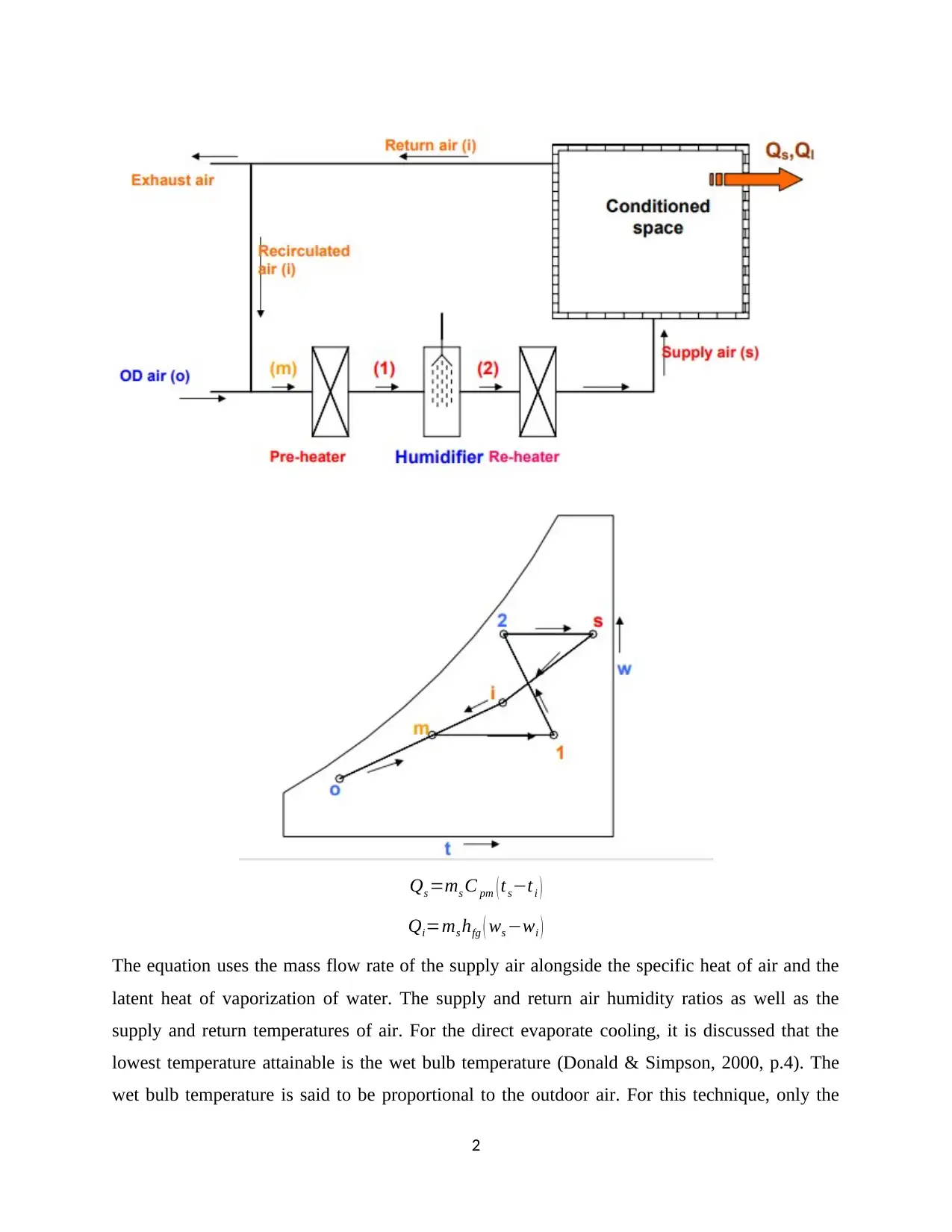
Qs =ms C pm ( ts−ti )
Qi=ms hfg ( ws −wi )
The equation uses the mass flow rate of the supply air alongside the specific heat of air and the
latent heat of vaporization of water. The supply and return air humidity ratios as well as the
supply and return temperatures of air. For the direct evaporate cooling, it is discussed that the
lowest temperature attainable is the wet bulb temperature (Donald & Simpson, 2000, p.4). The
wet bulb temperature is said to be proportional to the outdoor air. For this technique, only the
2
Qi=ms hfg ( ws −wi )
The equation uses the mass flow rate of the supply air alongside the specific heat of air and the
latent heat of vaporization of water. The supply and return air humidity ratios as well as the
supply and return temperatures of air. For the direct evaporate cooling, it is discussed that the
lowest temperature attainable is the wet bulb temperature (Donald & Simpson, 2000, p.4). The
wet bulb temperature is said to be proportional to the outdoor air. For this technique, only the
2
⊘ This is a preview!⊘
Do you want full access?
Subscribe today to unlock all pages.

Trusted by 1+ million students worldwide
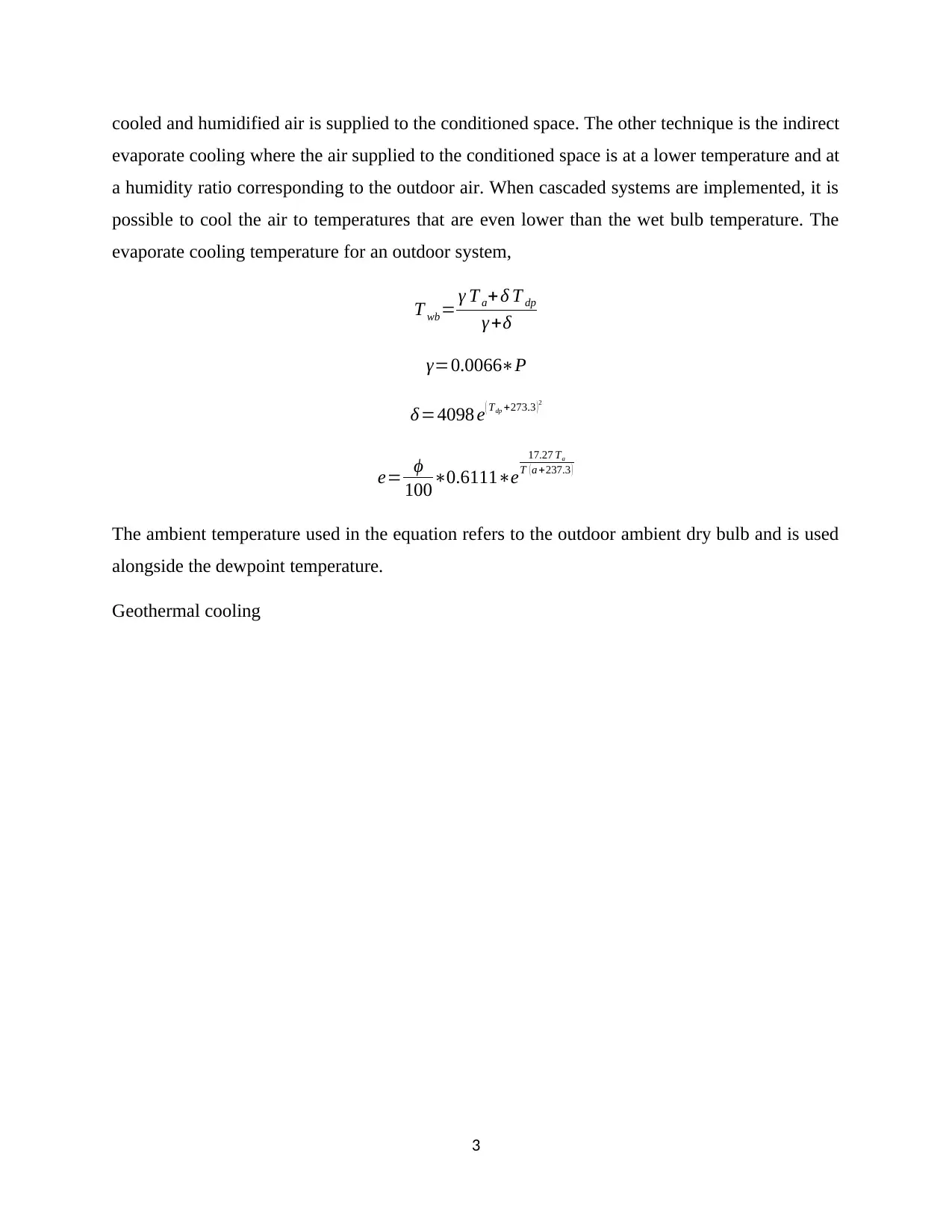
cooled and humidified air is supplied to the conditioned space. The other technique is the indirect
evaporate cooling where the air supplied to the conditioned space is at a lower temperature and at
a humidity ratio corresponding to the outdoor air. When cascaded systems are implemented, it is
possible to cool the air to temperatures that are even lower than the wet bulb temperature. The
evaporate cooling temperature for an outdoor system,
T wb= γ T a+δ T dp
γ +δ
γ=0.0066∗P
δ=4098 e ( Tdp +273.3 ) 2
e= ϕ
100∗0.6111∗e
17.27 Ta
T ( a +237.3 )
The ambient temperature used in the equation refers to the outdoor ambient dry bulb and is used
alongside the dewpoint temperature.
Geothermal cooling
3
evaporate cooling where the air supplied to the conditioned space is at a lower temperature and at
a humidity ratio corresponding to the outdoor air. When cascaded systems are implemented, it is
possible to cool the air to temperatures that are even lower than the wet bulb temperature. The
evaporate cooling temperature for an outdoor system,
T wb= γ T a+δ T dp
γ +δ
γ=0.0066∗P
δ=4098 e ( Tdp +273.3 ) 2
e= ϕ
100∗0.6111∗e
17.27 Ta
T ( a +237.3 )
The ambient temperature used in the equation refers to the outdoor ambient dry bulb and is used
alongside the dewpoint temperature.
Geothermal cooling
3
Paraphrase This Document
Need a fresh take? Get an instant paraphrase of this document with our AI Paraphraser
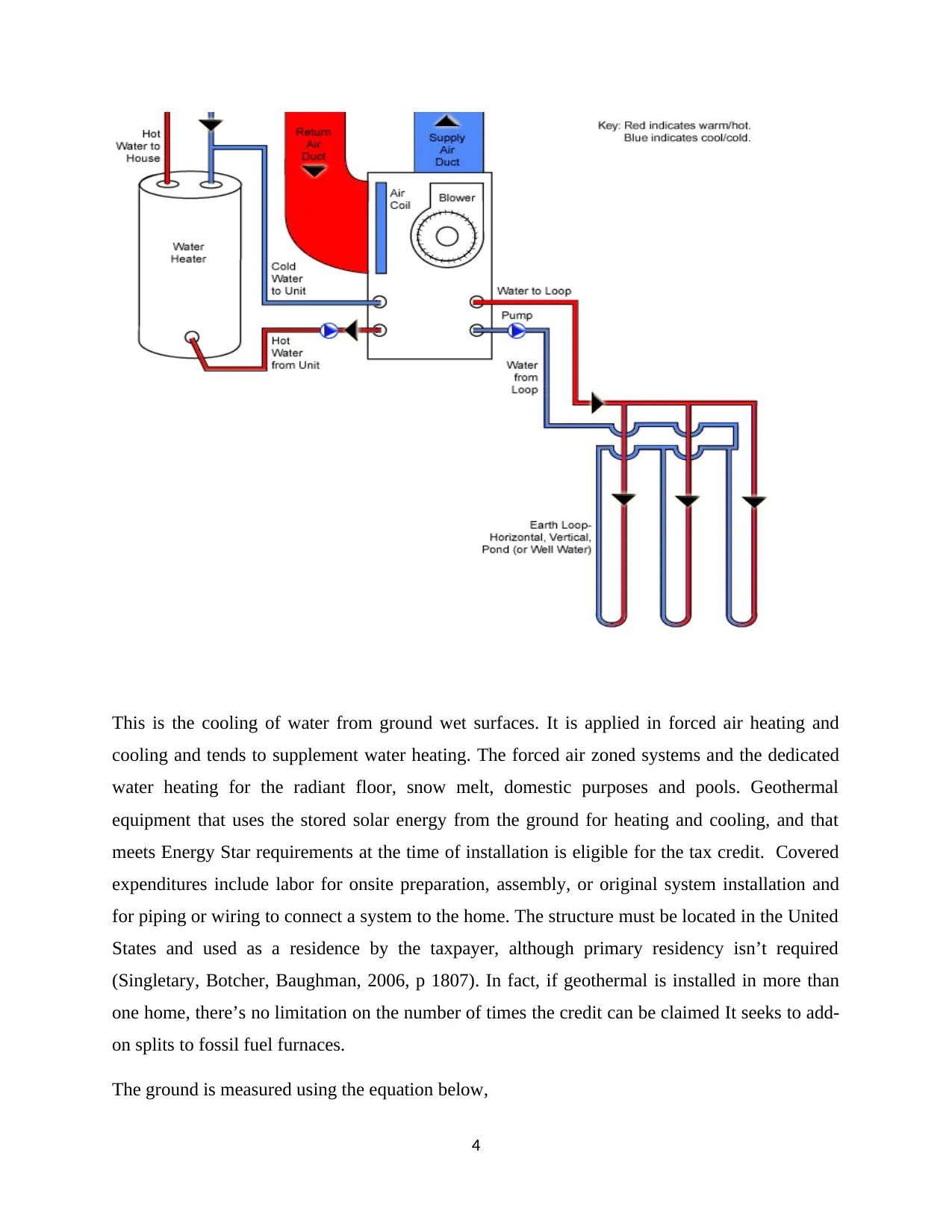
This is the cooling of water from ground wet surfaces. It is applied in forced air heating and
cooling and tends to supplement water heating. The forced air zoned systems and the dedicated
water heating for the radiant floor, snow melt, domestic purposes and pools. Geothermal
equipment that uses the stored solar energy from the ground for heating and cooling, and that
meets Energy Star requirements at the time of installation is eligible for the tax credit. Covered
expenditures include labor for onsite preparation, assembly, or original system installation and
for piping or wiring to connect a system to the home. The structure must be located in the United
States and used as a residence by the taxpayer, although primary residency isn’t required
(Singletary, Botcher, Baughman, 2006, p 1807). In fact, if geothermal is installed in more than
one home, there’s no limitation on the number of times the credit can be claimed It seeks to add-
on splits to fossil fuel furnaces.
The ground is measured using the equation below,
4
cooling and tends to supplement water heating. The forced air zoned systems and the dedicated
water heating for the radiant floor, snow melt, domestic purposes and pools. Geothermal
equipment that uses the stored solar energy from the ground for heating and cooling, and that
meets Energy Star requirements at the time of installation is eligible for the tax credit. Covered
expenditures include labor for onsite preparation, assembly, or original system installation and
for piping or wiring to connect a system to the home. The structure must be located in the United
States and used as a residence by the taxpayer, although primary residency isn’t required
(Singletary, Botcher, Baughman, 2006, p 1807). In fact, if geothermal is installed in more than
one home, there’s no limitation on the number of times the credit can be claimed It seeks to add-
on splits to fossil fuel furnaces.
The ground is measured using the equation below,
4
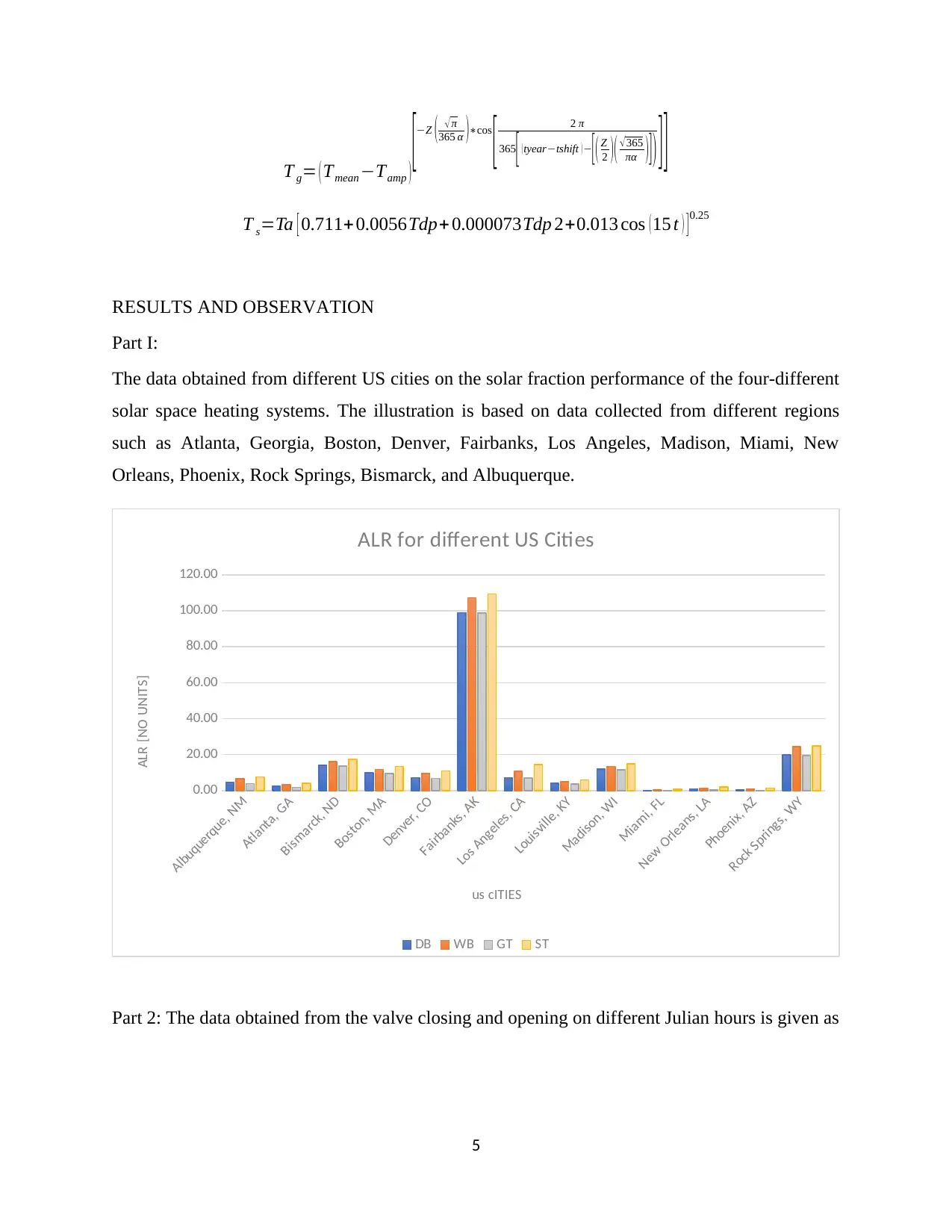
T g= ( Tmean −Tamp )
[−Z ( √π
365 α )∗cos
[ 2 π
365
[ (tyear−tshift )−
[( Z
2 )( √365
πα )]) ] ]
T s=Ta [ 0.711+ 0.0056Tdp+ 0.000073Tdp 2+0.013 cos (15 t ) ]0.25
RESULTS AND OBSERVATION
Part I:
The data obtained from different US cities on the solar fraction performance of the four-different
solar space heating systems. The illustration is based on data collected from different regions
such as Atlanta, Georgia, Boston, Denver, Fairbanks, Los Angeles, Madison, Miami, New
Orleans, Phoenix, Rock Springs, Bismarck, and Albuquerque.
Albuquerque, NM
Atlanta, GA
Bismarck, ND
Boston, MA
Denver, CO
Fairbanks, AK
Los Angeles, CA
Louisville, KY
Madison, WI
Miami, FL
New Orleans, LA
Phoenix, AZ
Rock Springs, WY
0.00
20.00
40.00
60.00
80.00
100.00
120.00
ALR for different US Cities
DB WB GT ST
us cITIES
ALR [NO UNITS]
Part 2: The data obtained from the valve closing and opening on different Julian hours is given as
5
[−Z ( √π
365 α )∗cos
[ 2 π
365
[ (tyear−tshift )−
[( Z
2 )( √365
πα )]) ] ]
T s=Ta [ 0.711+ 0.0056Tdp+ 0.000073Tdp 2+0.013 cos (15 t ) ]0.25
RESULTS AND OBSERVATION
Part I:
The data obtained from different US cities on the solar fraction performance of the four-different
solar space heating systems. The illustration is based on data collected from different regions
such as Atlanta, Georgia, Boston, Denver, Fairbanks, Los Angeles, Madison, Miami, New
Orleans, Phoenix, Rock Springs, Bismarck, and Albuquerque.
Albuquerque, NM
Atlanta, GA
Bismarck, ND
Boston, MA
Denver, CO
Fairbanks, AK
Los Angeles, CA
Louisville, KY
Madison, WI
Miami, FL
New Orleans, LA
Phoenix, AZ
Rock Springs, WY
0.00
20.00
40.00
60.00
80.00
100.00
120.00
ALR for different US Cities
DB WB GT ST
us cITIES
ALR [NO UNITS]
Part 2: The data obtained from the valve closing and opening on different Julian hours is given as
5
⊘ This is a preview!⊘
Do you want full access?
Subscribe today to unlock all pages.

Trusted by 1+ million students worldwide
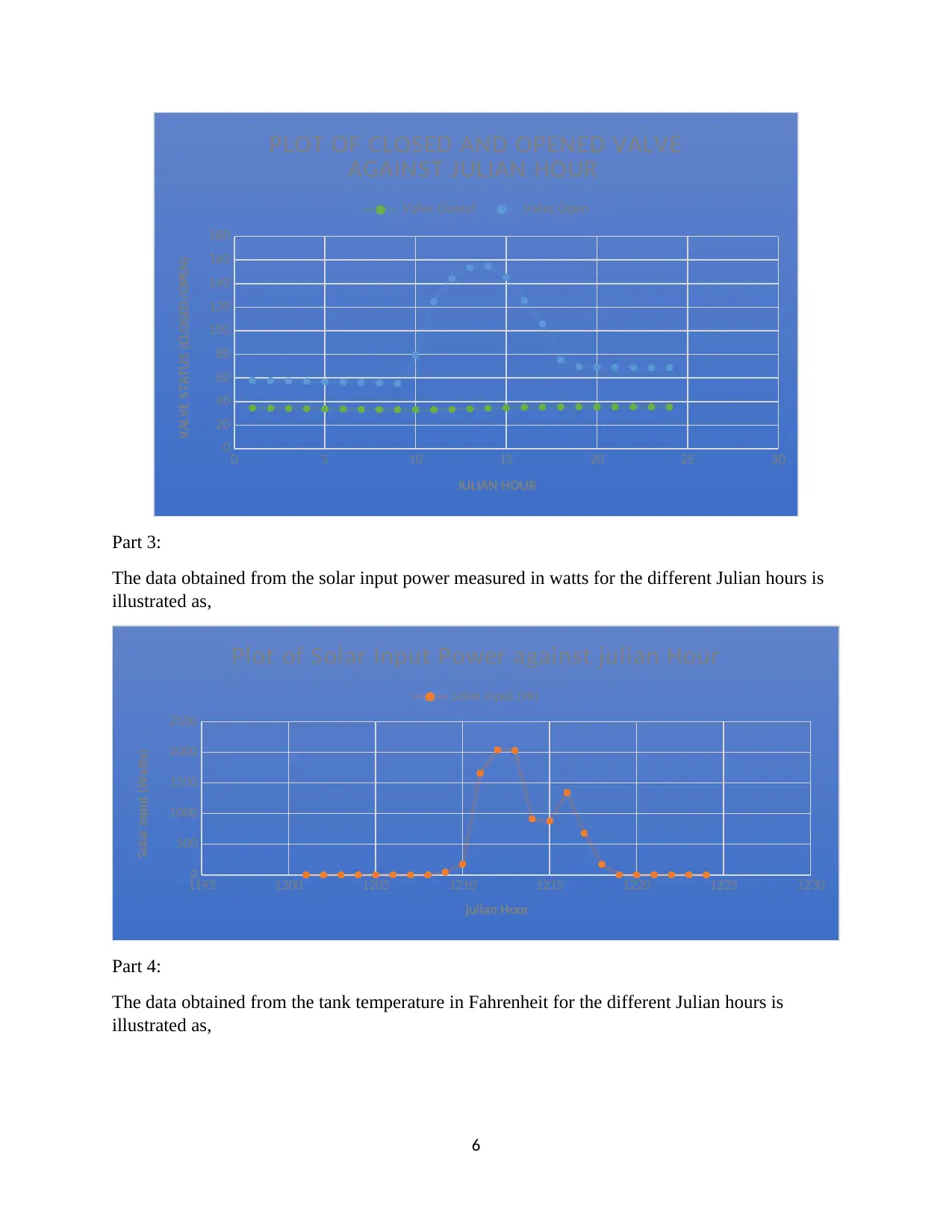
0 5 10 15 20 25 30
0
20
40
60
80
100
120
140
160
180
PLOT OF CLOSED AND OPENED VALVE
AGAINST JULIAN HOUR
Valve Closed Valve Open
JULIAN HOUR
VALVE STATUS (CLOSED/OPEN)
Part 3:
The data obtained from the solar input power measured in watts for the different Julian hours is
illustrated as,
1195 1200 1205 1210 1215 1220 1225 1230
0
500
1000
1500
2000
2500
Plot of Solar Input Power against julian Hour
Solar Input (W)
julian Hour
Solar Input (Watts)
Part 4:
The data obtained from the tank temperature in Fahrenheit for the different Julian hours is
illustrated as,
6
0
20
40
60
80
100
120
140
160
180
PLOT OF CLOSED AND OPENED VALVE
AGAINST JULIAN HOUR
Valve Closed Valve Open
JULIAN HOUR
VALVE STATUS (CLOSED/OPEN)
Part 3:
The data obtained from the solar input power measured in watts for the different Julian hours is
illustrated as,
1195 1200 1205 1210 1215 1220 1225 1230
0
500
1000
1500
2000
2500
Plot of Solar Input Power against julian Hour
Solar Input (W)
julian Hour
Solar Input (Watts)
Part 4:
The data obtained from the tank temperature in Fahrenheit for the different Julian hours is
illustrated as,
6
Paraphrase This Document
Need a fresh take? Get an instant paraphrase of this document with our AI Paraphraser
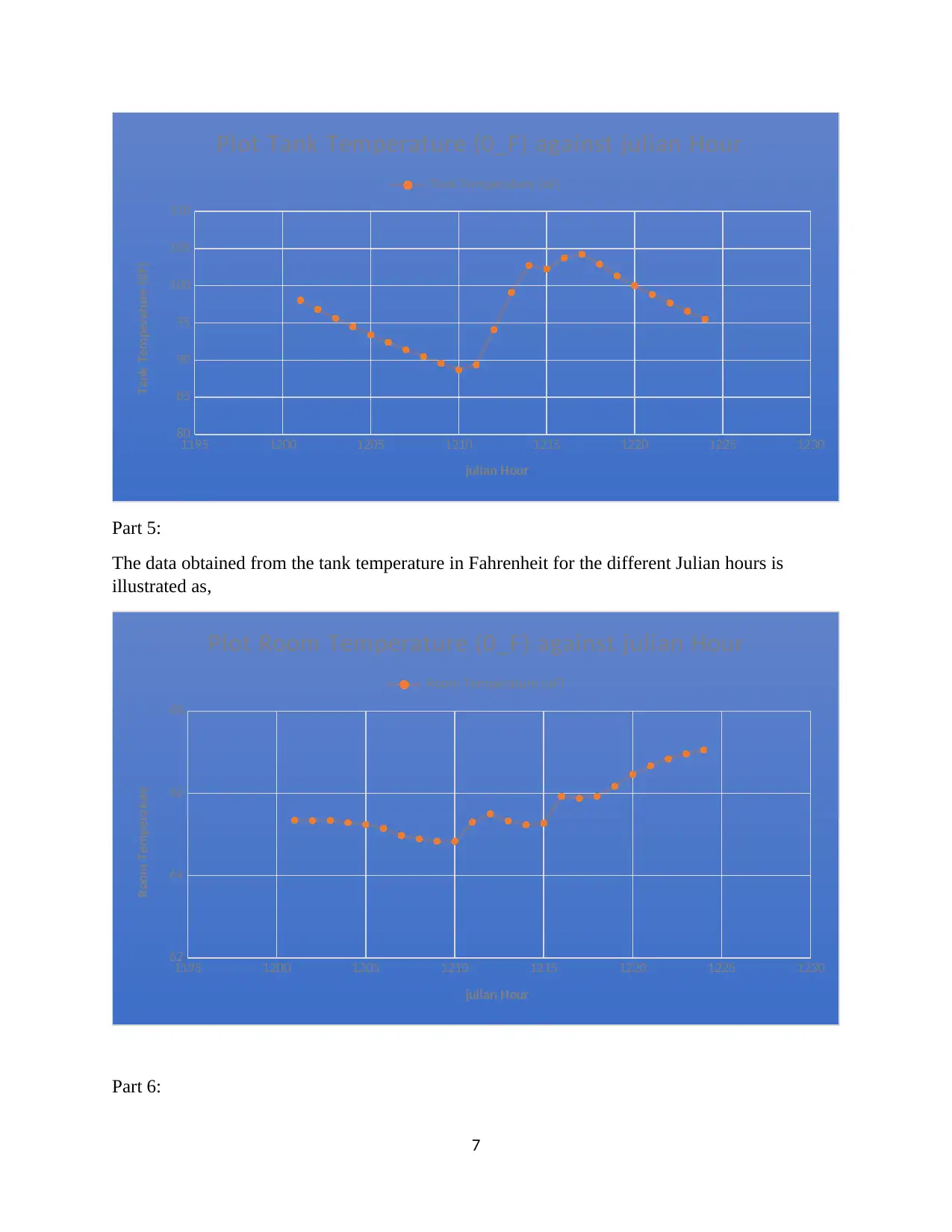
1195 1200 1205 1210 1215 1220 1225 1230
80
85
90
95
100
105
110
Plot Tank Temperature (0_F) against julian Hour
Tank Temperature (oF)
julian Hour
Tank Temperature (0F)
Part 5:
The data obtained from the tank temperature in Fahrenheit for the different Julian hours is
illustrated as,
1195 1200 1205 1210 1215 1220 1225 1230
62
64
66
68
Plot Room Temperature (0_F) against julian Hour
Room Temperature (oF)
julian Hour
Room Temperature
Part 6:
7
80
85
90
95
100
105
110
Plot Tank Temperature (0_F) against julian Hour
Tank Temperature (oF)
julian Hour
Tank Temperature (0F)
Part 5:
The data obtained from the tank temperature in Fahrenheit for the different Julian hours is
illustrated as,
1195 1200 1205 1210 1215 1220 1225 1230
62
64
66
68
Plot Room Temperature (0_F) against julian Hour
Room Temperature (oF)
julian Hour
Room Temperature
Part 6:
7
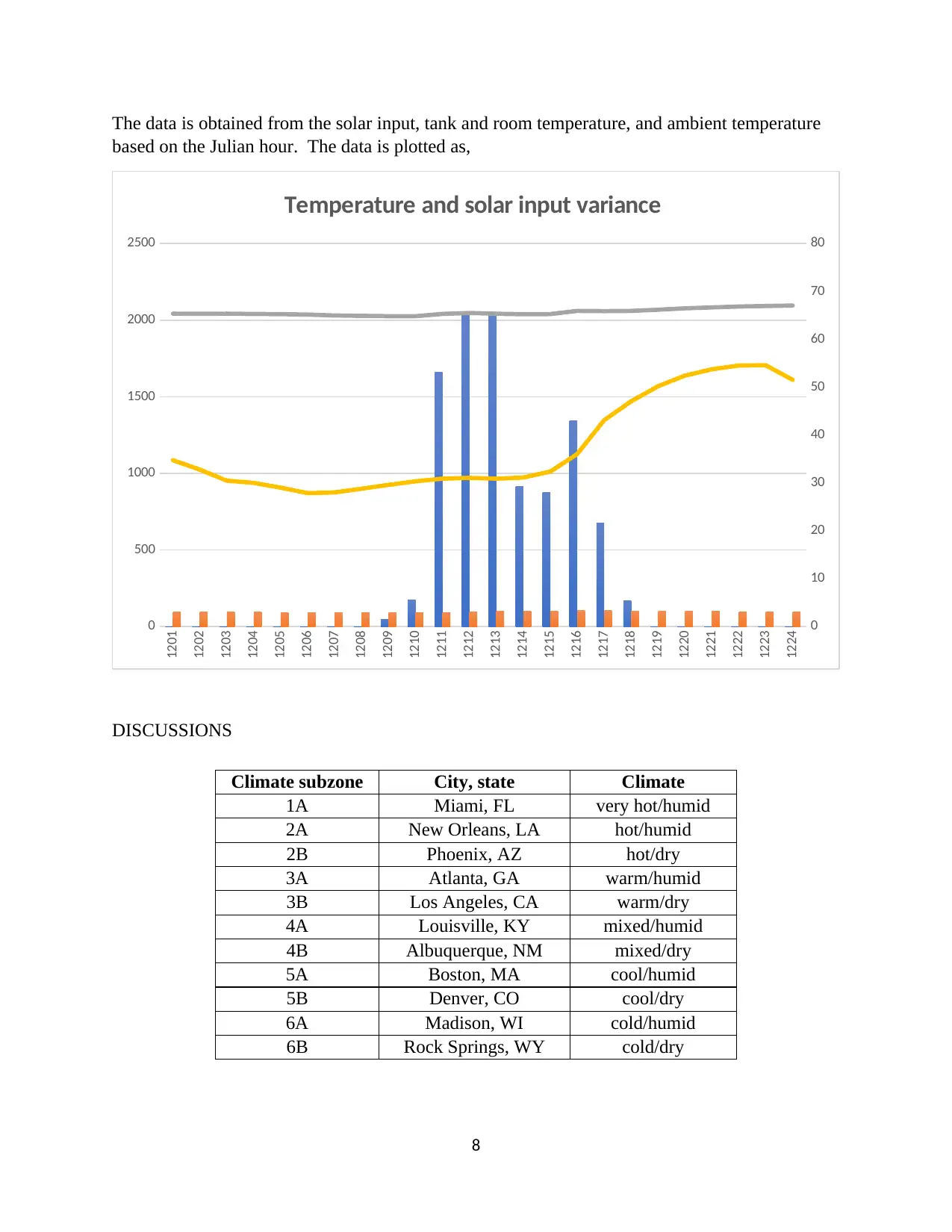
The data is obtained from the solar input, tank and room temperature, and ambient temperature
based on the Julian hour. The data is plotted as,
1201
1202
1203
1204
1205
1206
1207
1208
1209
1210
1211
1212
1213
1214
1215
1216
1217
1218
1219
1220
1221
1222
1223
12240
500
1000
1500
2000
2500
0
10
20
30
40
50
60
70
80
Temperature and solar input variance
DISCUSSIONS
8
Climate subzone City, state Climate
1A Miami, FL very hot/humid
2A New Orleans, LA hot/humid
2B Phoenix, AZ hot/dry
3A Atlanta, GA warm/humid
3B Los Angeles, CA warm/dry
4A Louisville, KY mixed/humid
4B Albuquerque, NM mixed/dry
5A Boston, MA cool/humid
5B Denver, CO cool/dry
6A Madison, WI cold/humid
6B Rock Springs, WY cold/dry
based on the Julian hour. The data is plotted as,
1201
1202
1203
1204
1205
1206
1207
1208
1209
1210
1211
1212
1213
1214
1215
1216
1217
1218
1219
1220
1221
1222
1223
12240
500
1000
1500
2000
2500
0
10
20
30
40
50
60
70
80
Temperature and solar input variance
DISCUSSIONS
8
Climate subzone City, state Climate
1A Miami, FL very hot/humid
2A New Orleans, LA hot/humid
2B Phoenix, AZ hot/dry
3A Atlanta, GA warm/humid
3B Los Angeles, CA warm/dry
4A Louisville, KY mixed/humid
4B Albuquerque, NM mixed/dry
5A Boston, MA cool/humid
5B Denver, CO cool/dry
6A Madison, WI cold/humid
6B Rock Springs, WY cold/dry
⊘ This is a preview!⊘
Do you want full access?
Subscribe today to unlock all pages.

Trusted by 1+ million students worldwide
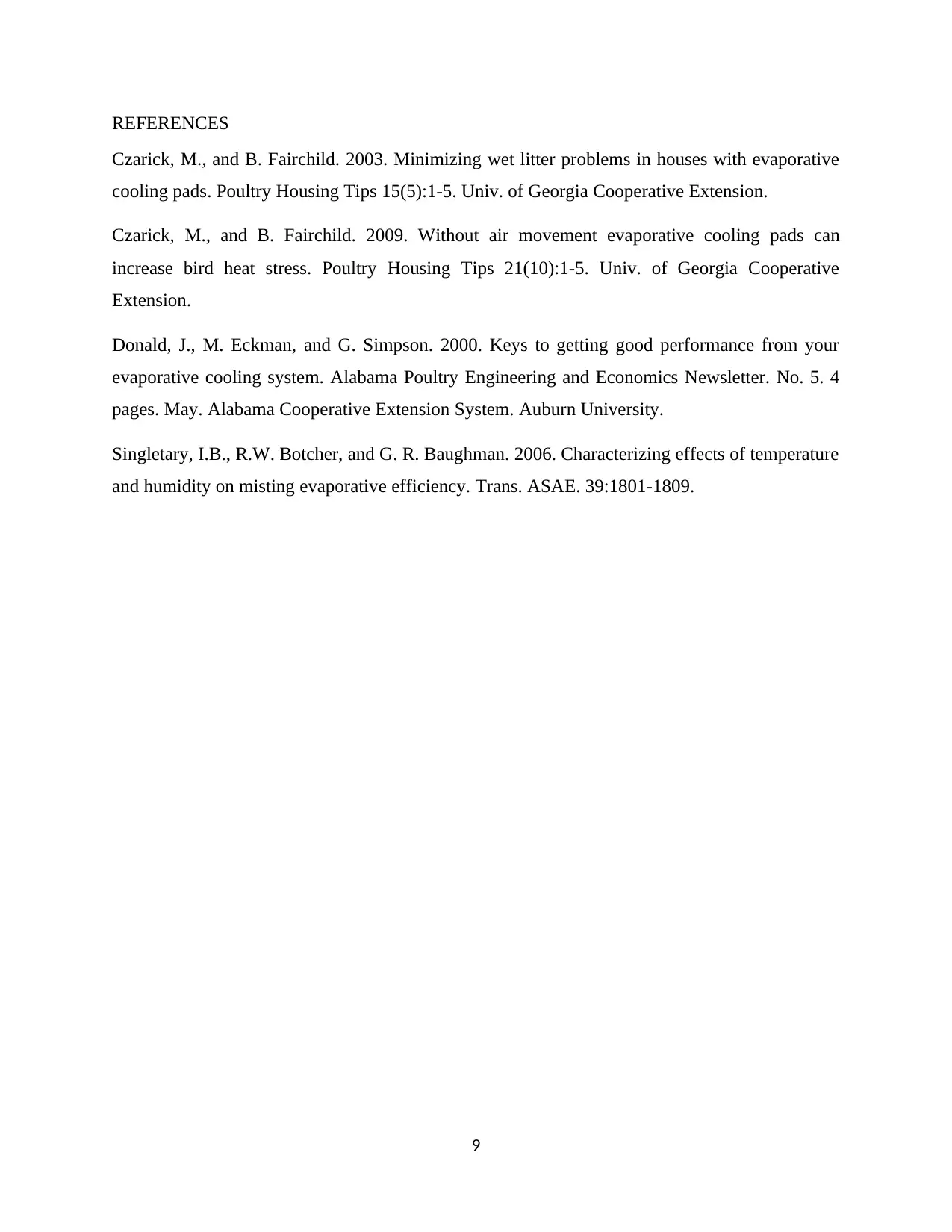
REFERENCES
Czarick, M., and B. Fairchild. 2003. Minimizing wet litter problems in houses with evaporative
cooling pads. Poultry Housing Tips 15(5):1-5. Univ. of Georgia Cooperative Extension.
Czarick, M., and B. Fairchild. 2009. Without air movement evaporative cooling pads can
increase bird heat stress. Poultry Housing Tips 21(10):1-5. Univ. of Georgia Cooperative
Extension.
Donald, J., M. Eckman, and G. Simpson. 2000. Keys to getting good performance from your
evaporative cooling system. Alabama Poultry Engineering and Economics Newsletter. No. 5. 4
pages. May. Alabama Cooperative Extension System. Auburn University.
Singletary, I.B., R.W. Botcher, and G. R. Baughman. 2006. Characterizing effects of temperature
and humidity on misting evaporative efficiency. Trans. ASAE. 39:1801-1809.
9
Czarick, M., and B. Fairchild. 2003. Minimizing wet litter problems in houses with evaporative
cooling pads. Poultry Housing Tips 15(5):1-5. Univ. of Georgia Cooperative Extension.
Czarick, M., and B. Fairchild. 2009. Without air movement evaporative cooling pads can
increase bird heat stress. Poultry Housing Tips 21(10):1-5. Univ. of Georgia Cooperative
Extension.
Donald, J., M. Eckman, and G. Simpson. 2000. Keys to getting good performance from your
evaporative cooling system. Alabama Poultry Engineering and Economics Newsletter. No. 5. 4
pages. May. Alabama Cooperative Extension System. Auburn University.
Singletary, I.B., R.W. Botcher, and G. R. Baughman. 2006. Characterizing effects of temperature
and humidity on misting evaporative efficiency. Trans. ASAE. 39:1801-1809.
9
1 out of 10
Your All-in-One AI-Powered Toolkit for Academic Success.
+13062052269
info@desklib.com
Available 24*7 on WhatsApp / Email
![[object Object]](/_next/static/media/star-bottom.7253800d.svg)
Unlock your academic potential
Copyright © 2020–2025 A2Z Services. All Rights Reserved. Developed and managed by ZUCOL.

